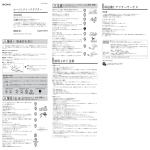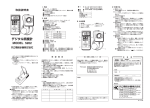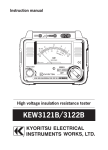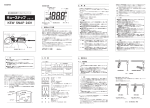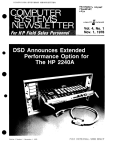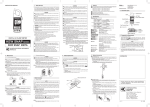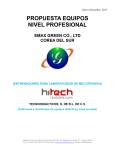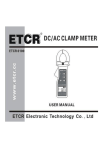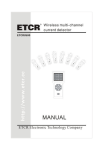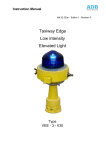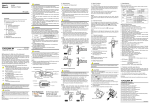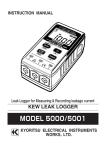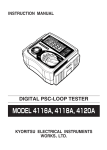Download Instruction Manual
Transcript
INSTRUCTION MANUAL 1. Safety Warnings This instrument has been designed and tested according to IEC Publication 61010: Safety Requirements for Electronic Measuring Apparatus. This instruction manual contains warnings and safety rules which must be observed by the user to ensure safe operation of the instrument and retain it in safe condition. Therefore, read through these operating instructions when using the instrument. WARNING Read through and understand instructions contained in this manual when using the instrument. AC CLAMP METER WITH DC VOLT RANGE Save and keep the manual handy to enable quick reference whenever necessary. KEW SNAP 6 Be sure to use the instrument only in its intended applications and to follow measurement procedures described in the manual. KEW SNAP 2608A Easy to use and dependable, the instrument is especially designed to incorporate as many safety features as possible. TRANSFORMER JAW BARRIER V TERMINAL JAW TRIGGER COM TERMINAL RANGE SWITCH OHM TERMINAL POINTER LOCK BUTTON ZERO ADJUSTER� OHM ZERO ADJUSTER SCALE PLATE WRIST STRAP Be sure to understand and follow all safety instructions contained in the manual. Failure to follow the above instructions may cause injury, instrument damage and/or damage to equipment under test. The symbol indicated on the instrument means that the user must refer to related parts in the manual for safe operation of the instrument. Be sure to carefully read the instructions following each symbol in this manual. DANGER:is reserved for conditions and actions that are likely to cause serious or fatal injury. WARNING :is reserved for conditions and actions that can cause serious or fatal injury. CAUTION:is reserved for conditions and actions that can cause injury or instrument damage Following symbols are used on the instrument and in the instruction manual. Attention should be paid to each symbol to ensure your safety. Refer to the instructions in the manual. This symbol is marked where the user must refer to the instruction manual so as not to cause personal injury or instrument damage. Indicates an instrument with double or reinforced insulation. Indicates that this instrument can clamp on bare conductors when measuring a voltage corresponding to the applicable Measurement category, which is marked next to this symbol. Indicates AC (Alternating Current). Indicates DC (Direct Current). Indicates AC and DC. DANGER Never make measurement on a circuit above 600V AC. Do not attempt to make measurement in the presence of flammable gasses, fumes, vapor or dust. Otherwise, the use of the instrument may cause sparking, which can lead to an explosion. Transformer jaw tips are designed not to short the circuit under test. If equipment under test has exposed conductive parts, however, extra precaution should be taken to minimize the possibility of shorting. Never attempt to use the instrument if its surface or your hand is wet. Do not exceed the maximum allowable input of any measurement range. Never open the battery compartment cover when making measurement. Never try to make measurement if any abnormal conditions, such as broken Transformer jaws or case is noted. The instrument is to be used only in its intended applications or conditions. Otherwise,safety functions, equipped with the instrument doesn t work, and instrument damage or serious personal injury may be caused. WARNING Never attempt to make any measurement, if the instrument has any structural abnormality such as cracked case and exposed metal part. Do not install substitute parts or make any modification to the instrument. Return the instrument to Kyoritsu or your distributor for repair or re-calibration. Do not try to replace the batteries if the surface of the instrument is wet. Remove the test leads from the instrument before opening the bottom case for battery or fuse replacement. KYORITSU ELECTRICAL INSTRUMENTS WORKS, LTD 3. Specifications Measuring Range and Accuracy Ranges Accuracy AC current 6/15/60/150/300A ±3% of full scale AC voltage 150/300/600V ±3% of full scale DC voltage 60V ±3% of full scale Resistance x1Ω 1kΩ (25Ω mid-scale) x10Ω 10kΩ (250Ω mid-scale) -20-+150℃ Temperature (with optional 7060) ±2% of scale length 4. Preparation for Measurement 5. Measurement 4−1 Releasing Pointer Lock Slide the pointer lock button to the right position to unlock the pointer. 5−1 AC Current Measurement 4−2 Meter Zero Adjustment Set the pointer at the center of the “0”mark on the scale by rotating the zero adjuster with a screw driver. ±5℃(0-+100℃) Model ±10℃ (other ranges) Overload Protection Range Maximum overload AC6/15A 60A AC for 10 sec AC60/150A 300A AC for 10 sec AC300A 360A AC for 10 sec AC150/300V 600V AC for 10 sec AC600V 720V AC for 10 sec DC60V 230V AC for 10 sec ×1Ω/×10Ω 230V AC, protection by fuse Location for use Conductor Size Safety Standard Withstand Voltage Dimensions Weight PowerSource Accessories (included) (optional) POINTER ZERO ADJUSTER :Indoor use, Altitude up to 2000m Storage Temperature and Humidity :-10-+50℃,relative humidity up to 75% without condensation Operating Temperature and Humidity POINTER LOCK BUTTON :0-+40℃, relative humidity up to 90% without condensation :Approx. 33mm diameter max. :IEC61010-1 CAT.III 300V CAT.II 600V IEC61010-2-031 IEC61010-2-032 :3700V AC for 1 minute between electrical circuit and housing cases or metal parts of jaws :193(L) × 78(W) × 39(D)mm :Approx.275g(battery included) :R6P(DC1.5V) battery or equivalent :Instruction manual Carrying case Model 9052 Test leads Model 7066 R6P battery(included within the instrument) Two 0.5A/250V 600V fuses(spare fuse included) :Model 8004,8008(Multi-Tran) Model7060(temperature probe) 4−3 Checking Battery Voltage a. Set the range switch to the “×1Ω” position. b. Insert the red test lead into the OHM terminal and the black test lead to the COM terminal. c. With the test leads shorted, try to set the pointer over the “0” mark at the right end of the resistance scale, using the OHM zero adjuster. d. When the adjustment brings the pointer over the “0” mark, proceed to measurement. If not, replace the battery. (See section 7 for battery and fuse replacement.) NOTE ・The battery is needed only in resistance measurement. AC/DC voltage and AC current measurement can be made without the battery. ・If the instrument does not operate properly even after battery replacement, check the fuse and test leads. WARNING ・Do not make measurement on a circuit above 600V AC. This may cause shock hazard or damage to the instrument or equipment under test. ・Transformer jaw tips are designed not to short the circuit under test. If equipment under test has exposed conductive parts, however, extra precaution should be taken to minimize the possibility of shorting. ・Do not make measurement with the bottom case removed. ・Do not make current measurement with the test leads connected to the instrument. ・Do not measure current exceeding the limit for the overload protection feature. ・Keep your fingers and hands behind the barrier during measurement. CAUTION ・When the order of the current under test is not known, make measurement first on the highest 300A range, then switch to the appropriate range. a. Set the range switch to the “AC 300A” position. b. Press the trigger to open the transformer jaws and clamp onto one conductor only. It is recommended that the conductor be placed at the center of the closed jaws. CORRECT WRONG CAUTION Make sure that the range switch is set to an appropriate position before making measurement. Always make sure to insert the plug of each test lead fully into the appropriate terminal on the instrument. When the instrument will not be in use for a long period of time, place it in storage after removing the batteries. Do not expose the instrument to the direct sun, extreme temperatures or dew fall. Use a damp cloth and detergent for cleaning the instrument. Do not use abrasives or solvents. ○Measurement categories(Over-voltage categories) To ensure safe operation of measuring instruments, IEC61010 establishes safety standards for various electrical environments, categorized as CATⅠto CATⅣ, and called measurement categories. Higher-numbered categories correspond to electrical environments with greater momentary energy, so a measuring instrument designed for CATⅢ environments can endure greater momentary energy than one designed for CATⅡ CAT.Ⅰ: Secondary electrical circuits connected to an AC electrical outlet through a transformer or similar device. CAT.Ⅱ: Primary electrical circuits of equipment connected to an AC electrical outlet by a power cord. CAT.Ⅲ: Primary electrical circuits of the equipment connected directly to the distribution panel, and feeders from the distribution panel to outlets. CAT.Ⅳ: The circuit from the service drop to the service entrance, and to the power meter and primary over-current protection device(distribution panel). Incoming wire Interior wiring CAT.Ⅲ CAT.Ⅳ Transformer CAT.Ⅰ Socket CAT.Ⅱ 2. Features Tear-drop-shaped jaws for ease of use in crowded cable areas and other tight places Safety design throughout. Designed to CAT.III 300V/CAT.II 600V and pollution degree 2 specified by the international safety standard IEC 61010. DC voltage range especially useful for checking a power supply for emergency use Pointer lock feature for easy reading in dimly light or hard-to-read locations Uses shrouded transformer jaws to further improve safety Optional temperature probe for temperature measurement c. Take the reading on the 300A current scale. d. Set the range switch to the appropriate position based on the reading. e. Take the reading on the appropriate scale. Range Scale used Multiply reading by AC6A 60A ×0.1 AC15A 150A ×0.1 AC60A 60A ×1 AC150A 150A ×1 AC300A 300A ×1 NOTE ・During current measurement, keep the transformer jaws fully closed. Otherwise, accurate measurement cannot be made. The maximum conductor size is 33mm in diameter. ・When measuring a larger current, the transformer jaws may buzz. This is not a fault and does not affect the accuracy at all. 5-2 AC Voltage Measurement WARNING ・Do not make measurement on a circuit above 600V AC. This may cause shock hazard or damage to the instrument or equipment under test. ・Do not make measurement with the bottom case removed. ・Do not apply to the instrument voltage exceeding the limit for the overload protection feature. ・Keep your fingers and hands behind the barrier during measurement. a. Set range switch to an AC voltage position. When the order of the voltage under test is not known, set the range switch to the highest 600V range. b. Insert the red test lead to the V terminal and the black test lead to the COM terminal. c. Connect the tip of the test leads to the circuit under test. CAUTION ・Make sure to remove the test leads from the terminals when resistance measurement is over. If the test leads are left inserted to the terminals, their inadvertent shorting can exhaust the battery. BLACK TEST LEAD d. Take the reading on the scale for the selected range. e. After completing the measurement, remove the test leads from the circuit under test. Range Scale used Multiply reading by AC150V 150V ×1 AC300V 300V ×1 AC600V 60V ×10 a. Set the range switch to the “×1Ω” or “× 10Ω” position. b. Insert the red test lead to the OHM terminal and the black test lead to the COM terminal. c. With the test leads shorted, set the pointer over the “0” mark at the right end of the resistance scale, using the OHM zero adjuster. WARNING ・Do not make measurement with the bottom case removed. ・Make sure that there is no voltage in the circuit or equipment under test. ・Keep your fingers and hands behind the barrier during measurement. 7−2 Fuse Replacement The instrument s resistance measuring circuit is protected by a 0.5A/250V 600V fuse. When the instrument does not operate properly in resistance measurement, check the fuse and replace it in the following steps, when necessary. a. Remove the test leads from the instrument. b. Remove the screw on the back side of the bottom case to open the instrument. c. Replace the blown fuse with the spare fuse installed beneath the battery. d. Screw the bottom case back onto the instrument. a. Make AC current, AC voltage, DC voltage or resistance measurement as described in section 5. POINTER LOCK BUTTON WARNING ・To avoid electric shock hazard, make sure to remove the test leads from the instrument before trying to replace batteries. ・Make sure to screw the bottom case back onto the instrument after battery or fuse replamement. ・Do not install a battery or fuse that does not have the specified rating. SCREW LOCK RELEASE WARNING ・Do not make measurement on a circuit above 60V DC. ・Do not make measurement with the bottom case removed. ・Keep your fingers and hands behind the barrier during measurement. 5−4 Resistance Measurement 7. Battery and Fuse Replacement The pointer lock feature can be used for measurement in dimly light or hard-to-read locations. BLACK TEST LEAD 5−3 DC Voltage Measurement a. Set range switch to the “DC 60V”position. b. Insert the red test lead to the V terminal and the black test lead to the COM terminal. c. Connect the red test lead tip to the positive side of the circuit under test and the black test lead tip to the negative side. d.Take the reading on the 60V scale. e. After completing the measurement, remove the test leads from the circuit under test. 6. Using Pointer Lock b. Slide the pointer lock button to the left position. c. Take the reading away from the conductor or the circuit under test. d. To release the pointer lock, slide the button to the right. RED TEST LEAD d. Connect the tip of the test leads to the circuit under test. e. Take the reading on the resistance scale and multiply it as follows. Range Scale used Multiply reading by ×1Ω Ω ×1 ×10Ω Ω ×10 8. Optional Accessaries Model 8004 and 8008 (Multi-Trans) Multi-Trans extend existing current measuring range up to 3000A as well as the maximum conductor size. WARNING ・Do not make measurement on a circuit above 600V AC. ・The transformer jaws are made of metal and their tips are not insulated. Never touch the exposed metal parts under test with jaw tips. ・Do not make measurement with the bottom case removed. ・Do not make measurement with the test leads connected to the instrument. a. Set the range switch to the “TEMP (×10Ω)” position. b. Insert the red test lead to the OHM terminal and the black test lead to the COM terminal. c. With the test leads shorted, set the pointer over the “0” mark at the right end of the resistance scale, using the OHM zero adjuster. d. Remove the test leads from the terminals. e. Insert Model 7060’s red plug to the OHM terminal and the black plug to the COM terminal. f. Touch the tip of the temperature probe to the part under test. g. Wait until the reading become stable, then take the reading on the temperature scale. CAUTION ・When the order of the current under test is not known, make measurement first on the highest 300A range, then switch to the appropriate range. Model8004 Model8008 Max. conductor Measuring Input to size range output ratio (mm in diameter) AC0∼ φ60 10:1 1000A AC0∼ φ100 10:1 3000A Model 7060 Model 7060 is an temperature probe with a measuring range from −20℃ to +150℃. WARNING Do not make measurement on a metal part with a voltage more than 30V AC or 60V DC. FUSE R6P BATTERY 7−1 Battery Replacement a. Remove the test leads from the instrument. b. Remove the screw on the back side of the bottom case to open the instrument. c. Replace the battery with a new R6P battery or equivalent. The new battery must be installed in the orientation indicated inside the instrument. d. Screw the bottom case back onto the instrument. 保 証 規 定 保証期間中に生じました故障は、以下の場合除き無償で 修理いたします。 1.取扱説明書によらない不適切な取扱い、使用方法、保 管方法が原因で生じた故障 2.お買い上げ後の持ち運びや輸送の間に、落下させるな ど異常な衝撃が加わって生じた故障 3.当社のサービス担当者以外の改造、修理、オーバーホ ールが原因で生じた故障 4.火災、地震、水害、公害およびその他の天変地異が原 因で生じた故障 5.傷などの外観上の変化 6.その他当社の責任とみなされない故障 7.電池など消耗品の交換、補充 8.保証書のご提出がない場合 ◎ご注意 当社で故障状態の確認をさせていただき、上記に該当 する場合は有償とさせていただきます。 輸送中に損傷が生じないように梱包を施し、当社修理 センターまたは取扱店宛にお送りください。 年月日 担当者 修理内容 保証書 a. Set the range switch to the desired position. b. Clamp Kew Snap 2608A onto the pick-up coil of Multi-Tran. c. Clamp Multi-Tran onto the bus-bar or conductor under test. d. Take the reading on Kew Snap 2608A and multiply it by 10. Models SPARE FUSE LLLLLLLLLLLLLLLLLLLLLLLLLLLLLLLLLLLLLLLLLLLLLLLL RED TEST LEAD 型名MODEL2608A 製造番号 保証期間 ご購入日( 年 月 日)より1カ年間 9.After-sales Service 9−1 Sending for Repair Make sure to provide description of the failure and your name, address and telephone number. Pack the instrument securely so that it will not be damaged during transportation and forward it to your distributor. 9−2 Periodic Calibration In order to maintain measurement accuracy, it is recommended that you forward the instrument to Kyoritsu Repair Center for calibration once every year. NOTE: Calibration is charged. KYORITSU reserves the rights to change specifications or designs described in this manual without notice and without obligations. KYORITSU ELECTRICAL INSTRUMENTS WORKS, LTD. No.5-20,Nakane 2-chome, Meguro-ku, Tokyo, 152-0031 Japan Phone : 81-3-3723-0131 Fax : 81-3-3723-0152 URL : http://www.kew-Itd.co.jp E-mail : [email protected] Factories : Uwajima & Ehime LLLLLLLLLLLLLLLLLLLLLLLLLLLLLLLLLLLLLLLLLLLLLLLL 04-10 9-09 92-1396D 92-1396C



